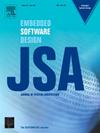Real-time scheduling for multi-object tracking tasks in regions with different criticalities
IF 3.7
2区 计算机科学
Q1 COMPUTER SCIENCE, HARDWARE & ARCHITECTURE
引用次数: 0
Abstract
Autonomous vehicles (AVs) utilize sensors such as LiDAR and cameras to iteratively perform sensing, decision-making, and actions. Multi-object tracking (MOT) systems are employed in the sensing stage of AVs, using these sensors to detect and track objects like pedestrians and vehicles, thereby enhancing situational awareness. These systems must handle regions of varying criticality and dynamically shifting locations, all within limited computing resources. Previous DNN-based MOT approaches primarily focused on tracking accuracy, but timing guarantees are becoming increasingly vital for autonomous driving. Although recent studies have introduced MOT scheduling frameworks with timing guarantees, they are either restricted to single-camera systems or fail to prioritize safety-critical regions in the input images. We propose CA-MOT, a Criticality-Aware MOT execution and scheduling framework for multiple cameras. CA-MOT provides a control knob that balances tracking accuracy in safety-critical regions and timing guarantees. By effectively utilizing this control knob, CA-MOT achieves both high accuracy and timing guarantees. We evaluated CA-MOT’s performance using a GPU-enabled embedded board commonly employed in AVs, with data from real-world autonomous driving scenarios.
求助全文
约1分钟内获得全文
求助全文
来源期刊

Journal of Systems Architecture
工程技术-计算机:硬件
CiteScore
8.70
自引率
15.60%
发文量
226
审稿时长
46 days
期刊介绍:
The Journal of Systems Architecture: Embedded Software Design (JSA) is a journal covering all design and architectural aspects related to embedded systems and software. It ranges from the microarchitecture level via the system software level up to the application-specific architecture level. Aspects such as real-time systems, operating systems, FPGA programming, programming languages, communications (limited to analysis and the software stack), mobile systems, parallel and distributed architectures as well as additional subjects in the computer and system architecture area will fall within the scope of this journal. Technology will not be a main focus, but its use and relevance to particular designs will be. Case studies are welcome but must contribute more than just a design for a particular piece of software.
Design automation of such systems including methodologies, techniques and tools for their design as well as novel designs of software components fall within the scope of this journal. Novel applications that use embedded systems are also central in this journal. While hardware is not a part of this journal hardware/software co-design methods that consider interplay between software and hardware components with and emphasis on software are also relevant here.
 求助内容:
求助内容: 应助结果提醒方式:
应助结果提醒方式:


